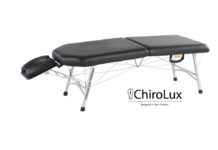
As doctors we frequently encounter patients with many conditions that are musculosketal in nature. In addition to providing Chiropractic care via the specific adjustment, one of the tools in the “arsenal” of many care recommendations is the use of some sort of topical analgesics to help alleviate pain symptoms and decrease inflammation.
Three of the biggest companies in the market today are Biofreeze, Cryoderm and Rocktape (which produces a product called RockSauce Chill).
We decided to perform a head to head comparison of these three products and then subjected 10 patients to various questions, situations and usages for each of the products.
We reached out to our partners over at MeyerDC to see if they would be so kind as to provide us with some samples for our testers and they happily obliged.
Before we get into the subjective answers that our testers provided; lets take a deeper look at the mechanism that each of these products are based upon and discuss how they work in the body.


 Biofreeze was first introduced in 1991 by a healthcare practitioner that was searching for a way to help his grandmother manage her arthritis pain. Today, Biofreeze products provide relief to countless arthritis sufferers. But the pain reliever’s unique, cooling formulation is also comforting to sore muscles and muscle sprains; easing back shoulder and neck pain; reducing painful ankle, knee, hip, and elbow joints and helping to lessen the effects of muscular strain. The active ingredient is menthol 3.5%. Biofreeze is be
Biofreeze was first introduced in 1991 by a healthcare practitioner that was searching for a way to help his grandmother manage her arthritis pain. Today, Biofreeze products provide relief to countless arthritis sufferers. But the pain reliever’s unique, cooling formulation is also comforting to sore muscles and muscle sprains; easing back shoulder and neck pain; reducing painful ankle, knee, hip, and elbow joints and helping to lessen the effects of muscular strain. The active ingredient is menthol 3.5%. Biofreeze is be
Cryoderm is formulated to immediately break the pain spasm cycle by overwhelming the topical receptors thereby eliciting the Gate Theory Of Pain Control. Once the pain signal is completely or significantly reduced the muscles no longer need to be in involuntary contraction, as they begin to release blood flows to the area breaking up the ischemic condition. Energy begins to be made aerobically as opposed to anaerobically stopping the production of lactic acid and the buildup of metabolic waste. While this is happening the essential Natural ingredients in the formula are penetrating deep into the tissue to create a long term anesthetic affect.
 The delivery of these key ingredients is aided by MSM which regulates the sodium potassium pumps in the cell thereby increasing permeability. Once delivered, peppermint oil stimulates the vascular and lymphatic system further aiding in the removal of metabolic waste and the reversal of the ischemic condition. Additionally other vital ingredients in CRYODERM have anti-inflammatory, anti-bruising, anti-spasmodic and anti-septic properties.
The delivery of these key ingredients is aided by MSM which regulates the sodium potassium pumps in the cell thereby increasing permeability. Once delivered, peppermint oil stimulates the vascular and lymphatic system further aiding in the removal of metabolic waste and the reversal of the ischemic condition. Additionally other vital ingredients in CRYODERM have anti-inflammatory, anti-bruising, anti-spasmodic and anti-septic properties.
Rocksauce Chill can be used to temporarily relieve minor aches and pains associated with arthritis, backaches,  strains, and sprains. This analgesic comes in a handy roll-on bottle, perfect for storing in a gym bags, purses, or backpacks. With ingredients like green tea, arnica, aloe, and 6% menthol (which is 33% more than the other leading brands), patients will enjoy a near immediate chill that provides hours of lasting relief for sore muscles and joints.
strains, and sprains. This analgesic comes in a handy roll-on bottle, perfect for storing in a gym bags, purses, or backpacks. With ingredients like green tea, arnica, aloe, and 6% menthol (which is 33% more than the other leading brands), patients will enjoy a near immediate chill that provides hours of lasting relief for sore muscles and joints.
Promote this pre-workout preventative on the shelves within your practice, and encourage patients to use it regularly. It rolls on mess-free, leaving no color or sticky residue on skin or equipment. RockSauce Chill can be also be used as a skin prep before applying kinesiology tape or directly through the tape at any time.
User Testing
We asked 10 people to try each of these products and then give feedback on each. Each subject tested an application of each product to their lumbar region, cervical region and posterior right shoulder.
Question #1: Which product do you feel produced the most immediate “cooling effect”?
A: 6 of 10 said Biofreeze, ( all six commented that they felt the ‘cold sensation” in less than 20 seconds after application), followed by 3 of 10 Cryoderm stated feeling cold within 45 seconds. 1 of 10 said Rocksauce Chill.
Question #2: Which product produced the deepest sensation of ‘cold’?
A: 5 of 10 said Cryoderm, 3 said Rocksauce Chill and 2 stated Biofreeze.
Question #3: Which product would you recommend to be used as a ‘medium’ when performing deep tissue massage or active release technique?
A: 8 of 10 said Cryoderm, 2 of 10 Biofreeze, 0 of 10 Rocksauce Chill
Questions #4: How or does the product ‘change’ over time when applied?
A: 10 of 10 said that Biofreeze stayed relatively the same in cold and penetration. Comments such as, “it’s cold from the minute you put it on and stays that way for up to two hours”, “it also never changed in depth of cold”.
All 10 subjects commented and said that the Cryoderm went through a metamorphosis over the course of a few minutes to hours. They all stated that they did not have the initial ‘shock’ of cold that Biofreeze provides, however over the course of 5-10 minutes they felt that the cold penetrated deeper and had a lasting effect. One tester even stated that they felt the Cryoderm stayed relatively cold for up to 5 hours.
Lastly, it was the common denominator that Rocksauce Chill started cold like Biofreeze, but penetrated deeper.
The group tried to compare the “depth” of the cold as to three different penetration layers. They said that Biofreeze was more of a topical cold, Rocksauce Chill a topical and intermediate and Cryoderm went even deeper into all three layers.
We then asked them to give us descriptive words for each of these products:
Biofreeze: instant cold, gel, green but rubs on clear, cold to the hand of the person applying, distinct smell, not to be used as medium for massage, lasting, effective.
Cryoderm: Deep cold, lasting, peppermint smell, can be used with massage, pleasant to apply, calming.
Rocksauce Chill: Trendy, sport, cold, a nice ‘medium’ depth of cold, a lot of menthol smell, something to use pre-post workout.
Question #5: Which product would you prefer and why?
A: 6 of 10 said that they liked the feel and depth of Biofreeze. They stated that they felt that if they wanted to use a topical that they wanted the cold to be as instant as possible and consistent.
3 of 10 said they preferred Cryoderm. These people stated they liked the more subtle cold introduction and a deeper more penetrating feeling that Cryoderm provides. They also stated that they felt Cryoderm lasted longer when applied.
1 of 10 said Rocksauce Chill. This person liked the ability to apply it pre and post workout. Note: this person stated that they use kinesiotape extensively and this topical is the only one that they felt is suitable with applying kinesiotape over the treated area.
In conclusion we come away with the thoughts that there is no clear cut winner as to what is the best topical analgesic on the market. These products all seem to have their own pros and cons to each of them. The best advice we could offer to you is to get a few bottles of each of them for yourself and try them on various patients.
It is apparent that the world of “topicals” is not a one size fits all for every patient.
 Our question to you is, “What do you think of these three products? Do you use them in your practice? Which do you like and why?”
Our question to you is, “What do you think of these three products? Do you use them in your practice? Which do you like and why?”
If you would like to try some of the products mentioned above please visit THIS LINK at MeyerDc and when you place your next order have them throw in a few bottles of each for you to test with your patients and let us know how it goes!








